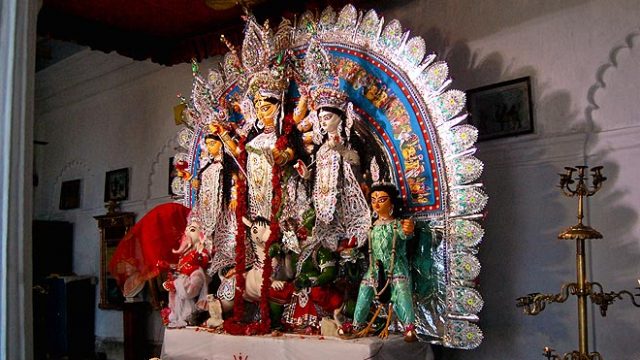Chhatubabu-Latubabu’s puja at Beadon Street
The Durga Puja was started in 1770 by a wealthy merchant of north Kolkata, Ramdulal Dey. His sons, who were popularly known as Chhatubabu and Latubabu, used to hold the festival in such a lavish manner that even today the household is popular by their names. The idol worshipped here is rather unique. Durga or Parvati sits on a lotus and is flanked by her two companions, Jaya and Vijaya.
Dutta family of Thanthania
Started by Dwarakanth Dutta in 1807, the family follows some unique traditions. Being followers of Vaishnavism, the family discarded the warrior image of the goddess. Instead, they worship an idol of Hara-Parvati, where Goddess Durga (Parvati) sits on her husband’s (Shiva or Hara’s) lap. They are flanked by their children. The family follows a unique ritual—burning charcoal is placed in clay plates (malsa); married women place these on their heads and palms and pray to the goddess.
Laha family of Thanthania
The festival is organised by turn each year by the various branches of the Laha family at their respective houses (in different locations in north Kolkata). Here too, the idol of Hara-Parvati flanked by their children is worshipped.
Mallick family of Bhowanipore
It is not difficult to spot this traditional family homestead in south Kolkata—the residence of Bengal’s famous cine-star duo—father Ranjit Mallick and daughter Koel Mallick. The puja at the Kolkata household dates back to 1925, when the family home shifted to the city. Before that the puja used to be held at their village home. Like many Vaishnav families, they too do not have animal sacrifices.
Mitra family of Darjipara
The Durga Puja of the Mitra family of Darjipara (north Kolkata) dates back to 1807. The idol-making still follows the old tradition, including the strange-shaped lion at the feet of the goddess.
Sabarna Roy Choudhury family of Barisha
Located down south in Kolkata, the Sabarna Roy Choudhury family is one of the oldest families of Kolkata. It was this family from whom the East India Company—in 1698—rented the three villages of Govindapur, Sutanati and Kalikata, which later became Calcutta. The family still follows the age-old rituals but has discontinued animal sacrifice.
Shovabazar Rajbari
After Robert Clive won the battle of Plassey in 1757, Raja Nabakrishna Dev of Shovabajar Rajbari feted Clive and other members of the East India Company at home during Durga Puja. A festival that was restricted to household now became a popular attraction. Even today people flock to this traditional household in north Kolkata to observe the age-old customs and rituals being followed during the festival. Like most traditional homes, here too the goddess and her family share one backdrop (locally known as ekchala)
Information: Be prepared for crowds and traffic jams during Durga Puja in Kolkata. For outstation visitors, the best way to go around is by availing the package tours offered by West Bengal Tourism and private operators. Carry drinking water and light rain gear.




